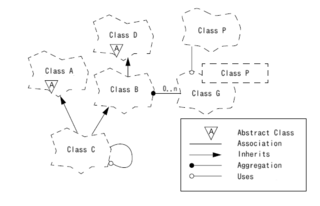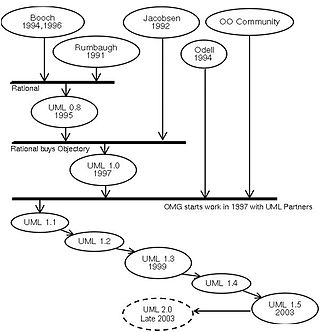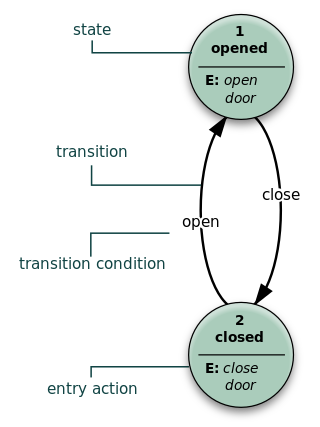Related Research Articles

The Booch method is a method for object-oriented software development. It is composed of an object modeling language, an iterative object-oriented development process, and a set of recommended practices.

An object-modeling language is a standardized set of symbols used to model a software system using an object-oriented framework. The symbols can be either informal or formal ranging from predefined graphical templates to formal object models defined by grammars and specifications.

The unified modeling language (UML) is a general-purpose visual modeling language that is intended to provide a standard way to visualize the design of a system.
A software company is an organisation — owned either by the state or private — established for profit whose primary products are various forms of software, software technology, distribution, and software product development. They make up the software industry.
The rational unified process (RUP) is an iterative software development process framework created by the Rational Software Corporation, a division of IBM since 2003. RUP is not a single concrete prescriptive process, but rather an adaptable process framework, intended to be tailored by the development organizations and software project teams that will select the elements of the process that are appropriate for their needs. RUP is a specific implementation of the Unified Process.
The Shlaer–Mellor method, also known as object-oriented systems analysis (OOSA) or object-oriented analysis (OOA) is an object-oriented software development methodology introduced by Sally Shlaer and Stephen Mellor in 1988. The method makes the documented analysis so precise that it is possible to implement the analysis model directly by translation to the target architecture, rather than by elaborating model changes through a series of more platform-specific models. In the new millennium the Shlaer–Mellor method has migrated to the UML notation, becoming Executable UML.
Object-oriented analysis and design (OOAD) is a technical approach for analyzing and designing an application, system, or business by applying object-oriented programming, as well as using visual modeling throughout the software development process to guide stakeholder communication and product quality.
Together is a product from Micro Focus, formerly from Borland, formerly from TogetherSoft, that currently integrates a Java IDE, which originally had its roots in JBuilder, with a UML modeling tool.

StarUML is a software engineering tool for system modeling using the Unified Modeling Language, as well as Systems Modeling Language, and classical modeling notations. It is published by MKLabs and is available on Windows, Linux and MacOS.
ObjecTime Limited of Kanata, Ontario was a software company with the known software product ObjecTime Developer.
Object-oriented modeling (OOM) is an approach to modeling an application that is used at the beginning of the software life cycle when using an object-oriented approach to software development.
Model-driven engineering (MDE) is a software development methodology that focuses on creating and exploiting domain models, which are conceptual models of all the topics related to a specific problem. Hence, it highlights and aims at abstract representations of the knowledge and activities that govern a particular application domain, rather than the computing concepts.
Object-oriented design (OOD) is the process of planning a system of interacting objects for the purpose of solving a software problem. It is one approach to software design.
Rational Rose XDE, an "eXtended Development Environment" for software developers, integrates with Microsoft Visual Studio .NET and Rational Application Developer. The Rational Software division of IBM, which previously produced Rational Rose, wrote this software.
Rational Rhapsody, a modeling environment based on UML, is a visual development environment for systems engineers and software developers creating real-time or embedded systems and software. Rational Rhapsody uses graphical models to generate software applications in various languages including C, C++, Ada, Java and C#.

Rational Software Modeler (RSM), made by IBM's Rational Software division, is a Unified Modeling Language (UML) 2.0-based visual modeling and design tool. Rational Software Modeler is based on the Eclipse open-source software framework and is used for visual modeling and model-driven development (MDD) with UML for creating applications and web services. IBM ceased marketing Rational Software Modeler in 2010 and ended support for it in 2015. Much of the same functionality is now available through Rational Software Architect.

UML is a modeling language used by software developers. UML can be used to develop diagrams and provide users (programmers) with ready-to-use, expressive modeling examples. Some UML tools generate program language code from UML. UML can be used for modeling a system independent of a platform language. UML is a graphical language for visualizing, specifying, constructing, and documenting information about software-intensive systems. UML gives a standard way to write a system model, covering conceptual ideas. With an understanding of modeling, the use and application of UML can make the software development process more efficient.
Real-Time Object-Oriented Modeling (ROOM) is a domain-specific language.
eTrice is a CASE-Tool for the development of real-time software. It is an official Eclipse project.